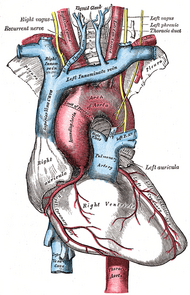Assessment |
Biopsychology |
Comparative |
Cognitive |
Developmental |
Language |
Individual differences |
Personality |
Philosophy |
Social |
Methods |
Statistics |
Clinical |
Educational |
Industrial |
Professional items |
World psychology |
Biological: Behavioural genetics · Evolutionary psychology · Neuroanatomy · Neurochemistry · Neuroendocrinology · Neuroscience · Psychoneuroimmunology · Physiological Psychology · Psychopharmacology (Index, Outline)
| Aortic body | ||
|---|---|---|
| The heart, thoracic aorta and other great vessels (aortic body not visible, but aortic arch labeled at center) | ||
| Latin | Glomus aorticum, corpora paraaortica | |
| Gray's | subject #277 1277 | |
| System | ||
| MeSH | A08.800.550.700.120.600.050 | |
| [[Image:|190px|center|]] | ||
The aortic body is one of several small clusters of chemoreceptors, baroreceptors, and supporting cells located along the aortic arch.
Function[]
It measures changes in blood pressure and the composition of arterial blood flowing past it, including the partial pressures of oxygen and carbon dioxide and pH.[1] The chemoreceptors responsible for sensing changes in blood gases are called glomus cells.
It gives feedback to the medulla oblongata via the afferent branches of the vagus nerve (X). The medulla, in turn, regulates breathing and blood pressure.
Disorders[]
A paraganglioma is a tumor that may involve the aortic body.
Swelling can also occur.
Nomenclature[]
Some sources equate the "aortic bodies" and "paraaortic bodies", while other sources explicitly distinguish between the two.[2][3] When a distinction is made, the "aortic bodies" are chemoreceptors which regulate Circulatory system, while the "paraaortic bodies" are the chromaffin cells which manufacture catecholamines.
See also[]
References[]
Cardiovascular system, physiology: cardiovascular physiology | |
|---|---|
| Volumes |
Preload - Afterload - End-systolic volume - End-diastolic volume - Frank-Starling law of the heart |
| Interactions |
Cardiac output - Wiggers diagram - Pressure volume diagram |
| Tropism |
Chronotropic - Dromotropic - Inotropic |
| Hemodynamics |
Baroreflex - Kinin-kallikrein system - Renin-angiotensin system - Vasoconstrictors - Vasodilators - Compliance - Vascular resistance |
| Other |
Electrical conduction system of the heart (Cardiac action potential) |
Template:Arteries of chest
| This page uses Creative Commons Licensed content from Wikipedia (view authors). |
